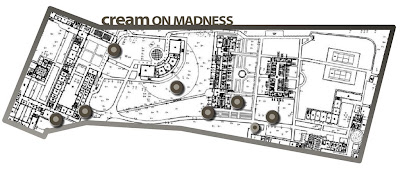




Excerpt of the catalogue presentation of Tracce written by Gloria Vallese, historian of art and curator of CREAM ON MADNESS.
For this intervention at San Servolo, Dania Zanotto has imagined a group of five tents, an entire small village placed under the trees. These tents are “shamanic”, with reference to a sense of intense of communion with nature, and also to a "living outside", living far away, in a nomadic dimension, suspended between travel and exile. Lightly moved by the breeze, they are are built out of gauze and with materials that suggest natural objects, like ice and bark. Inside, bowls, pillows and carpets are laid on a carpet of anthracite sand, which initially is circular, but which the wind removes day by day, changing slowly its shape.
Suspended to the trees are clothes; evocation of the worn clothes, deserted by the spirits, that the Tungusi abandon hanging them to the branches in the forest. These also, like the tents, are evocation of an era, perhaps mythical, in which men understood the language of birds and the signs of the nature.
This diaphanous village of houses without roots, quiet and silent, animated only by the wind, evokes absent human beings. It is ideally in dialogue with the former patients of the San Servolo asylum, the crazy "guests" relegated here, away from the community; guests whose perception was altered, and therefore, like the shamans, forced to isolation.
Also in the European tradition, like in the rest of the world, madmen and idiots were considered in a certain way prophets, and lived isolated, wandering at random when they were not restricted. A condition in many ways similar to that of the shamans, who, when announcing a prophecy or the pronuncing the formula for an healing, lead themselves to a crisis followed by hallucinations, and are feared and kept away from the community for such behaviours, that themselves are not able to control.
A refined use of materials (those that appear as ice or bark are actually special resins, set on a base of gauze that makes diaphanous and disembodied this ghost village), together with the idea of a house which is no more than the materialization of a thought, may suggest a relationship between these creations by Dania Zanotto and some of the work of the Asian sculptor Do Ho Suh. Emigrated to the USA from his native Korea, Do Ho Suh evokes to the most minute details the house left in his homeland with thin inflatable structures in transparent plastic, hung from the ceiling, floating and without roots.
In fact, the points of departure are very different, because Dania Zanotto’s inspirational objects for sculpture and installation are, and have been for a long time, the tents and textiles of the ancient nomadic civilizations. The nomadic garment is loaded with symbols, hides among its folds ornaments, amulets, objects of everyday life, expands its meaning and function to the point of becoming a sort of mobile home, whose contours coincide with the boundaries of body. The nomadic tent, on the contrary, is a minimal home, the spare, essential furniture of which must meet the most diverse needs of living.
TRACCE (TRACES)
(gauze, resin, plastic, paint,
polyurethane, sand, metal)
Variable size
(each element diameter/height 200 x 250 x 280cm)
2008




























